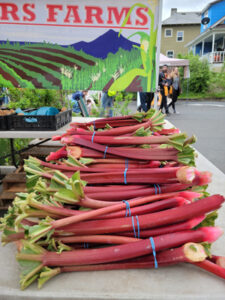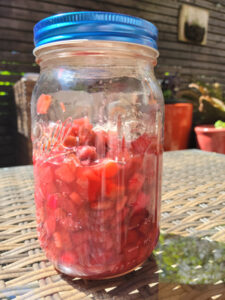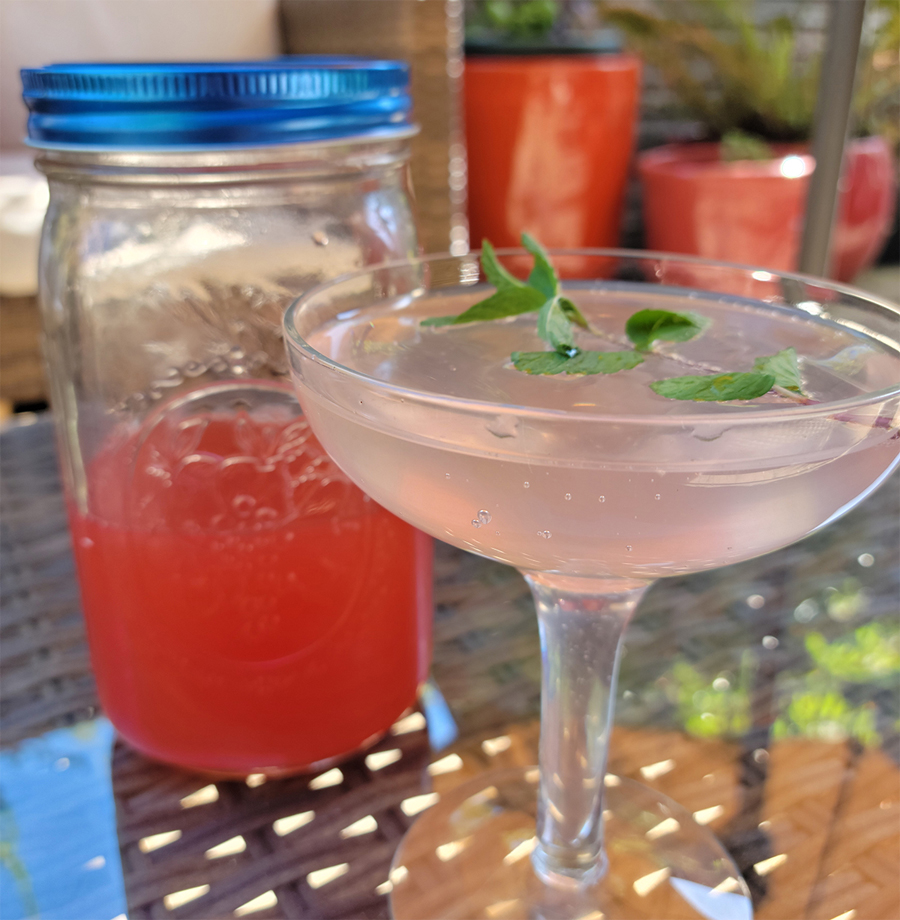When you’re swimming in pie plant, turn those crimson red stalks into a drink called ‘shrub’
Rhubarb is an especially prolific vegetable crop in Oregon. Good thing it’s so versatile — it’s suitable for sweet and savory dishes, served hot or cold, and transformed into jams, sauces and even beverages.
 Oregon is No. 1 among U.S. states that grow rhubarb, according to the Oregon Department of Agriculture’s list of top 20 agricultural commodities, with Washington and Wisconsin coming in second and third.
Oregon is No. 1 among U.S. states that grow rhubarb, according to the Oregon Department of Agriculture’s list of top 20 agricultural commodities, with Washington and Wisconsin coming in second and third.
Get the Recipe: Rhubarb Shrub
There are typically two harvests: a first cut of stalks in late April to May, and a second in late June into July. So, between now and the middle of summer, we can expect to see those crimson red stalks in abundance at local farmers markets.
If you prefer to grow your own, rhubarb makes a great addition to an edible landscape. Just remember that the edible portion of the plant is the stalk – and only the stalk! The big, beautiful leaves, looking like green elephant ears, are toxic to humans and animals due to their high concentration of oxalic acid. You’d need to eat around 10 pounds of rhubarb leaves to reach a lethal dose of oxalic acid, although consuming much less than that could still cause nausea, vomiting and stomach pain.
There are more than 60 species of rhubarb. Many of these are culinary types (Rheum × hybridum). The leading variety for outdoor production is Crimson, also known as Crimson Cherry, Crimson Red or Crimson Wine: It’s a prodigious producer of bright red stalks. Other varieties grown in Oregon include Valentine, Canada Red and MacDonald — all red varieties — and Riverside Giant, a green variety. Victoria is a variety that produces green stalks with pink to red speckles. There’s also an ornamental variety (Rheum palmatum) with deep red foliage that’s beautiful in the landscape, but the stalks are not edible.
 Pie is by far the most common recipe you’ll find when searching for ways to use rhubarb, hence its nickname — “the pie plant.” Due to rhubarb’s terrifically tart taste, most recipes call for an ample amount of sugar to make it palatable, although I encourage cooks to experiment with the ratio of rhubarb to sweetener and find their ideal balance of sweet to tart.
Pie is by far the most common recipe you’ll find when searching for ways to use rhubarb, hence its nickname — “the pie plant.” Due to rhubarb’s terrifically tart taste, most recipes call for an ample amount of sugar to make it palatable, although I encourage cooks to experiment with the ratio of rhubarb to sweetener and find their ideal balance of sweet to tart.
That tartness is what makes rhubarb sing, as in this zingy beverage called a “shrub.” Typically a fruit-infused syrup fortified with vinegar (or alcohol), a shrub preserves the essence and flavor of fresh rhubarb and develops depths of flavor and complexity over time.
Also called drinking vinegars, shrubs can be purchased in specialty food and beverage stores, but they’re super simple to make at home. Shrubs make excellent craft cocktails, mocktails, or you can sip them by the tablespoonful as an energy drink or digestive aid.
Rhubarb Shrub
Rhubarb stalks 1 pound, cleaned and diced into ¼-inch pieces (about 4 cups)
Sugar 1 cup
Apple cider vinegar 1 cup
Add the diced rhubarb and granulated sugar to a mason jar and give it a good shake to mix the ingredients. Put a lid on the jar and place it in the fridge for 4-5 days, up to a week, giving it a shake every day. With each passing day a pink syrup will start to form as the rhubarb releases its juices and melds with the sugar.
After several days, strain the liquid, pressing down hard on the solids (reserve the solids for reuse – see below). Mix the syrup with vinegar and pour into a lidded jar and refrigerate. You can use the shrub immediately, but after a week, the flavors will deepen. Add a teaspoon or two to cocktails, mocktails or sparkling water. The shrub will keep for up to a year.
The strained solids are edible, too. Put them in a saucepan with 1 cup of water and 1 tablespoon grated ginger, and simmer for about 20-30 minutes until the rhubarb has broken down and thickened into a sauce. Try a spoonful or two with your morning yogurt and granola, or serve with grilled pork, salmon or tofu.

